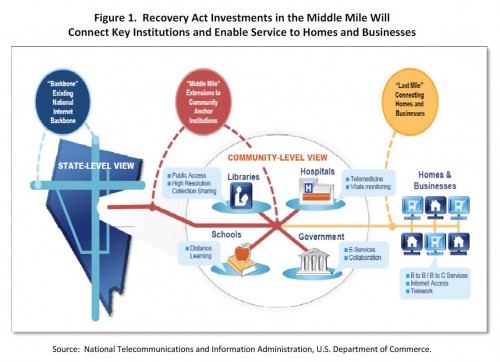In America, a collaborative method of connecting rural areas to broadband

Public funding for the "middle-mile", a mix of private and public for the "last-mile". Source: http://broadbandbreakfast.com/wp-content/uploads/2009/12/NEC-Broadband-Report.pdf
Often, when speaking about the penetration of broadband on the African continent, the comparison is made with developed nations such as the United States. However, even in the U.S., broadband is not a given. Many rural areas are still without broadband infrastructure and face difficulties obtaining the dollars needed to connect a small population to an Internet backbone hundreds of miles away. As America struggles to reach 100% broadband penetration, Africa should take note on how the nation is making progress, as the same situation is already beginning to unfold at home.
Currently, about 73% of U.S. households have adopted broadband – and that statistic varies by about 10%. How can millions more people be connected to broadband lines in only a matter of years? It takes a collaborative effort between the federal government, state government, local government, non-profits, and private sector. Funding such an endeavor is perhaps the greatest initial challenge, but such an obstacle can be overcome if the national government feels the economic benefits outweigh the cost.
Let’s take a current example from the United States. The American government is vastly aware of the potential economic boost by adding better Internet connectivity to underserved areas. The National Economic Council’s Recovery Act states this awarenes:
For millions of Americans without adequate access to broadband, however, the possibility of falling behind in the knowledge-based economy is real. Recognizing this concern, the American Recovery and Reinvestment Act provided $7.2 billion to stimulate economic growth and create jobs by expanding the deployment and adoption of broadband services.
Under the Recovery Act, the National Telecommunications and Information Administration (NTIA), an agency established by the Commerce Department, receives grant applications from various government, non-profit, and private organizations representing individual states. Essentially, each state has an organization assume responsibility for the broadband project. Then, after reviewing each case, the NTIA awards the grant to these organizations, who have two years to enhance the broadband infrastructure in their region. Once the “middle-mile” connections are in place, “last-mile” connections will be added, hopefully with the help of private investment. Transparency is a high priority; the goals and statuses of each project will be made available to policymakers and consumers. Also, it is worth noting that the awards come with requirements for “open interconnection,” meaning that grantees must make any infrastructure funded with taxpayer dollars available for interconnection with other networks.
As a more granular example of the aforementioned Act, take the state of Maine. Rural parts of the state recently received $25 million from the broadband stimulus program. The proposal, sponsored by several Maine telecommunications companies, would bring high-speed Internet access to more than 100 rural communities that currently have few or no options. The extensive project still requires an additional $7.5 million in funding beyond the government grant. From the news article:
The Three Ring Binder concept would create three fiber-optic rings, one in northern Maine, one from midcoast to Down East and one in western Maine, encompassing 1,100 miles. Those rings would be a shared resource open to all qualified Internet providers.
The project’s total cost is estimated at $32.5 million and would bring broadband to communities with 110,000 households, 600 anchor institutions, 10 University of Maine System campuses and outreach centers, three community colleges and 38 government facilities.
Most notably:
- The government does not intend to fund the entire project. It’s up to private groups of universities to come up with the rest of the necessary money. Furthermore, no single group is given too much power.
- Measures have been taken to prevent telecommunication provider monopolies.
Although African governments are structured differently than in the U.S. and funding may perhaps be more difficult to attain, there is no reason why policymakers in Africa should ignore the outline of the Recovery Act. Please be sure to read the entire 16-page document: PDF (1.33 MB)
The Three Ring Binder concept would create three fiber-optic rings, one in northern Maine, one from midcoast to Down East and one in western Maine, encompassing 1,100 miles. Those rings would be a shared resource open to all qualified Internet providers.
The project’s total cost is estimated at $32.5 million and would bring broadband to communities with 110,000 households, 600 anchor institutions, 10 University of Maine System campuses and outreach centers, three community colleges and 38 government facilities.












 Twitter
Twitter Facebook
Facebook Pinterest
Pinterest